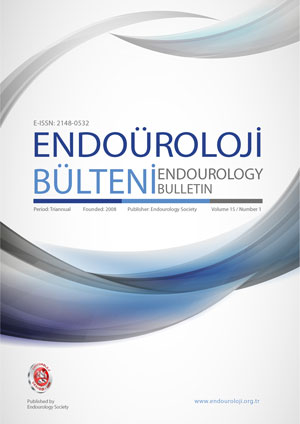
Editorial Board Message
Prof.Dr. R. Gökhan ATIŞ
Editorial Borad
Arbitrators List
Contents
Original Article
What may be Related to Patient Satisfaction in Prostate Biopsies?
Prostat Biyopsilerinde Hasta Memnuniyeti Nelerle İlişkili Olabilir?
Abstract
Objective: To investigate the factors affecting patient satisfaction in patients undergoing prostate biopsy.
Material and Methods: Two hundred thirty seven of 241 patients, aged between 48 and 86, those who are decided to undergo transrectal ultrasonography (TRUS)-guided prostate biopsy, were evaluated prospectively. Age, body mass index (BMI), prostate-specific antigen (PSA) values, prostate volume, positive digital rectal examination (DRE) findings and biopsy indications of the patients were recorded before the procedure. The level of pain felt during biopsy was scored by visualised pain scoring (VAS). Patient satisfaction was evaluated with a 4-point scale after biopsy.
Results: Of the 237 patients evaluated, 92 were dissatisfied with the procedure, while 145 were satisfied. The mean age of Group 1 and Group 2 were 65.9±8.1 and 66.1 ± 7.6 years, BMI were 27.7±4.0 and 26.3 ± 3.9 kg/m2, PSA level were 58.6 ± 304.6 and 17.9 ± 68.1 ng/ml, Prostate volume were 59.4 ± 51.8 and 51.8 ± 28.7 cc., The median VAS score was 4 (3-6) and 4 (2.5-6) respectively.
The satisfaction levels of positive DRE findings Group was 3 (2-3) while negative 3 (2-3), Tumor existance Group was 3 (2-3) while no tumor Group’s Satisfaction levels 3 (2-3), Perineural invasion of tumor existance Group was 3 (2-3) while other Group’s Satisfaction levels 3 (2-3).
Conclusion: In TRUS-guided prostate biopsies, no relationship was found between the patient’s satisfaction level and the patient’s age, PSA level, prostate volume, the level of pain felt, positive DRE finding, positive Tumor pathology or having perineural invasion of the tumor histologically. There is a statistically significant relationship between BMI and the level of satisfaction.
Keywords: Pain level, Prostate biopsy, Positive tumor pathology, Perineural invasion
Original Article
Approach to Forgotten Ureteral Stents: A Single Tertiary Center Experience of 49 Cases
Cengiz Çanakcı, Erdinç Dinçer, Burak Doğrusever, Mahmut Selman Mert, Orkunt Özkaptan
Abstract
Objective: Double J (DJ) stents are widely used in urology practice. Forgotten ureteral stents can cause serious complications. We present our experience about forgotten ureteral stents with 49 cases.
Material and Methods: The data of patients who were operated due to forgotten encrusted ureteral stents were examined retrospectively. Age, gender, side, presenting complaint, indwelling time, stent indication, surgery performed, complications, additional interventions and stone-free status were evaluated. For descriptive statistics, the mean, standard deviation, minimum and maximum frequencies and percentages were used.
Results: Nineteen (38.8%) patients were female and 30 (61.2%) patients were male. The mean age of the patients was 47,06±14,11 (18-79). The mean indwelling time was 16.2±21,1 (3-120). Stents were placed in 30 patients due to stone surgery, 9 patients due to prophylactic before oncologic surgery, 8 patients due to hydronephrosis and two patients due to ureteral injury. For the treatment of the forgotten stent, ureteroscopy (including flexible ureterorenoscopy) was performed in 26 patients, endoscopic combined treatment in 11 patients, cystolithotripsy in 9 patients, open surgery in two patients and percutaneous nephrolithotomy in one patient.
Conclusion: Removal of forgotten impacted ureteral stents can cause serious complications. The patients who were placed stents should be informed about the complications associated with forgotten encrusted stents.
Keywords: Ureteral Stents, Forgotten DJ, Encrustation, Indwelling Time
Original Article
Evaluation of the Use of Long Term DJ Stents in Ureteral Obstructions That Cannot Be Treated Curatively
Özgür Arıkan, İlkin Hamid-zada, Ferhat Keser, Mustafa Kaan Akalın, Özgür Efiloğlu, Asıf Yıldırım
Abstract
Objective: Ureteral obstructions may develop due to intrinsic or extrinsic, benign or malignant etiology and may cause loss of renal function, pain and recurrent urinary system diseases. Curative treatments for etiology are not always possible. We aimed to evaluate the clearance and salvage of this long term DJ stent, which has ureteral obstruction but can not be performed with curative surgery.
Material and Methods: One hundred and thirty-one patients who underwent long term DJ stent application due to ureteral obstruction between 2015 and 2022 were followed up and evaluated retrospectively. Demographic data of the patients, ureteral obstruction etiology, follow-up period and complications were recorded. The 4.8F-26cm, Boston Percuflex™Plus Ureteral Stent was used in the patients and was planned to be replaced once a year.
Results: Of the 131 patients included in this study, 40 (30.53%) had malignant ureteral obstruction and 91 (69.47%) had benign ureteral obstruction. The average follow-up period was found to be 35.4 months. During their follow-up, 18 (13.74%) patients had symptoms such as stent related pain and dysuria, 11 (8.39%) had recurrent urinary tract infection, 8 (6.1%) had encrusted DJ stents, 3 (2.29%) had DJ stent migration and hematuria that requiring blood transfusion was observed in 1 (0.76%) patient.
Conclusions: Our study showed that the use of long term ureteral DJ stent is a safe and effective option in malignant and benign ureteral obstructions.
Keywords: Ureteral obstruction, Long term DJ stent, Curative surgery
Original Article
A Technical Tip to Minimize Dorsal Vein Complex Bleeding in Extraperitoneal Laparoscopic Radical Prostatectomy: Using Balloon of the Urethral Catheter
Abdullah Gölbaşı, Eren Cengiz, Hüseyin Biçer, Gökhan Sönmez, Murat Keske, Mert Ali Karadağ
Abstract
Objective: We aimed to present a technical tip that can stop bleeding in the form of leakage after control of the dorsal vein complex (DVC) during laparoscopic radical prostatectomy and its results.
Material and Methods: Patients who underwent extraperitoneal laparoscopic radical prostatectomy between May 2021 and August 2023 were included in the study. In all patients, a 16 Fr foley catheter was placed through the urethra to control minimal bleeding from the DVC, and traction was applied for 15 min with a 25 ml inflated balloon. Demographic characteristics, Prostate Specific Antigen (PSA) values, gleason scores, prostate volumes and operation times were recorded.
Results: A total of 95 patients were included in the study. The mean age, PSA and prostate volume values were 67.2 (49-76) years, 8.43 (4-21) ng/ml, 46.32 (28-79) ml, respectively, while the median Gleason score value was 6 (6-8). The mean operation time was 162.5 (126-237). Mean operative times were not different from those of patients who did not participate in the study.
Conclusions: In our opinion, catheter balloon compression is a safe and feasible technique to control bleeding and facilitate anastomosis under clear visualization. This technique needs to be supported by prospective, randomized, double-blind studies.
Keywords: Prostate Cancer, Dorsal Vein Complex, Laparoscopy










